
Do you have a question about the Sony TRINITRON CPD-G400 and is the answer not in the manual?
Procedure for testing AC leakage from exposed metal parts.
Interpreting green and flashing orange power indicator lights for diagnostics.
Steps to remove the monitor's outer cabinet.
Removing EMI shields and side covers for access.
Procedure to remove the A board from the monitor.
Removing rear shield assembly and D board.
Steps for removing the H board.
Procedures for safely removing the picture tube.
Diagram showing the routing and connection of internal harnesses.
Procedure for adjusting high voltage levels for safe operation.
Checking the beam current protector function.
Verifying the Over Current Protection function.
Initial adjustments for screen geometry and purity.
Detailed fine-tuning of screen geometry and purity.
Initial H and V convergence adjustments using magnets.
Specifications for white balance adjustment.
Specifications for picture position and size.
Adjusting focus volume 1 and 2 for optimum picture focus.
Overview of the monitor's functional blocks and interconnections.
Identifying the physical location of main circuit boards A, D, N, H.
High-level schematic showing connections between major boards.
Detailed schematics and printed wiring board layouts for A board.
Pinpointing semiconductor locations on the A board.
Diagram showing chassis parts and assembly order.
Diagram illustrating picture tube assembly and related parts.
List of parts included in the monitor's packaging.
Safety and operational precautions for monitor use.
Front and rear view of the monitor, identifying all buttons and connectors.
Steps to connect the monitor cable to various computer types.
Instructions for connecting the monitor's power cord.
Correct order for turning on the monitor and computer.
Steps to take if no image appears on the screen.
How to display and move through the monitor's menu system.
Adjusting the horizontal and vertical centering of the picture.
Adjusting picture size, centering, and zoom options.
Adjusting picture rotation and shape.
Adjusting picture color temperature for optimal display.
Accessing and adjusting monitor options like degauss and menu position.
How to display the main menu and select adjustment items.
Procedure for adjusting the monitor's brightness and contrast levels.
Using the AUTO function to automatically size and center the picture.
Manually adjusting the picture's horizontal and vertical size.
Enlarging or reducing the picture using the ZOOM function.
Methods for resetting monitor adjustments to default settings.
Manually degaussing the monitor to remove magnetic interference.
Reducing wavy patterns on the screen using moire cancellation.
Adjusting the on-screen menu's position for better visibility.
Advice on setting the correct display resolution for optimal picture.
Instructions for adjusting refresh rate to reduce picture flicker.
Resolving distorted picture shapes by adjusting geometry.
Correcting out-of-focus images by adjusting convergence.
Monitor automatically matching input signals to factory preset modes.
Monitor's compliance with VESA, ENERGY STAR, and NUTEK power-saving guidelines.
Explanation of normal damper wires appearing as thin lines on screen.
Interpretation of common on-screen messages and their solutions.
Troubleshooting steps for unstable picture display.
Steps to resolve a fuzzy or out-of-focus picture display.
Eliminating ghosting by checking cables and removing interference sources.
Adjusting picture centering and sizing for proper display.
Correcting curved image edges by adjusting geometry.
Reducing moire patterns by adjusting cancellation or degaussing.
Addressing color uniformity issues by checking connections or degaussing.
Correcting white color issues by adjusting color temperature or degaussing.
Resolving red/blue shadows by adjusting convergence.
Troubleshooting when monitor buttons are unresponsive.
Addressing issues with the image restoration feature.
Explaining normal humming during auto-degauss cycle.
Steps to remove the monitor's outer cabinet.
Removing EMI shields and side covers for access.
Procedure to remove the A board from the monitor.
Removing rear shield assembly and D board.
Placing the monitor in a service position for component access.
Steps for removing the H board.
Procedures for safely removing the picture tube.
Diagram showing the routing and connection of internal harnesses.
Procedure for adjusting high voltage levels for safe operation.
Checking the high voltage hold-down function.
Checking the beam current protector function.
Verifying the Over Current Protection function.
Verifying power supply operation and line voltage.
Initial adjustments for screen geometry and purity.
Detailed fine-tuning of screen geometry and purity.
Initial H and V convergence adjustments using magnets.
Specifications for horizontal and vertical convergence accuracy.
Specifications for white balance adjustment.
Specifications for picture position and size.
Adjusting focus volume 1 and 2 for optimum picture focus.
Overview of the monitor's functional blocks and interconnections.
Identifying the physical location of main circuit boards A, D, N, H.
High-level schematic showing connections between major boards.
Identifying the physical location of main circuit boards A, D, N, H.
Detailed schematics and printed wiring board layouts for A board.
Pinpointing semiconductor locations on the A board.
Diagram showing chassis parts and assembly order.
Diagram illustrating picture tube assembly and related parts.
List of parts included in the monitor's packaging.
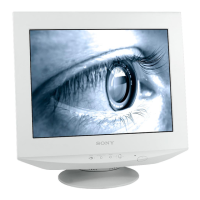
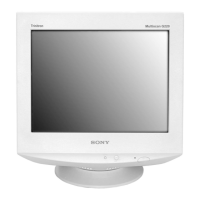


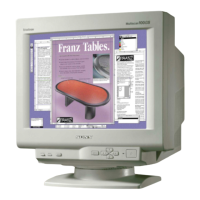
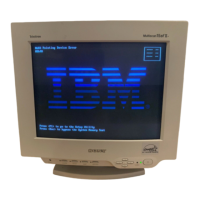




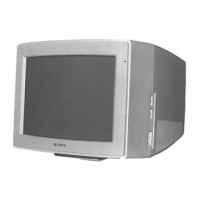
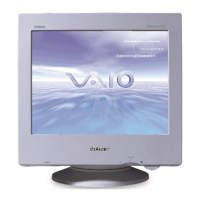
